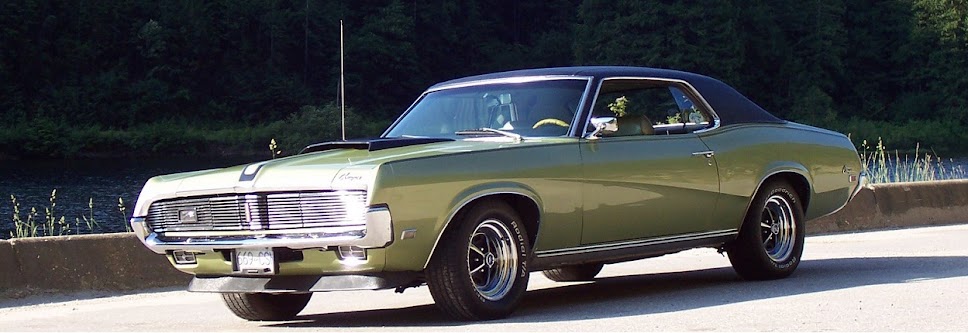Comments: The 1970 Mercury Cougar was even larger than the year before and sported new styling. Returning was the Eliminator, now with a standard 351 Cleveland four-barrel carb rated at 300 bhp. Optional engines included the Boss 302, 428 CJ and a new big block, the 429 V8 with Ram-Air induction and 375 bhp. Despite these improvements, sales continued to decline.
The 1970 Mercury Cougar Eliminator was one of the more eccentric offerings from the Mercury’s line of muscle cars. Cougar was launched for the 1967 model year as Mercury’s version of Ford’s original Mustang pony car. In keeping with Lincoln-Mercury’s upscale mission, the Cougar rode a Mustang chassis that had been stretched three inches to give the car a 111-inch wheelbase and a more boulevard ride. Additional sound-deadening material and some extra amenities were added in an effort to capture more of a sports-luxury-touring feel.
While the Cougar would always be a beat behind the lighter, more lithe Mustang in all-out performance, that didn’t stop Mercury from sharpening its cat’s claws. Right from the start, the Cougar GT and XR-7 offered a choice of powerteams that included the 289-cubic-inch two- and four-barrel V-8s, and the 390 High Performance V-8. (The 271-horsepower High Performance 289 V-8 never was available as a Cougar option.)
The best-balanced 1970 Mercury Cougar Eliminator package
had the 351-cid V-8, which had 300 bhp.
Cougar bounded into its second season with an array of sporty options that included the XR-7G (Dan Gurney Special) with gold interior appointments. More exotic was the GTE (GT-Eliminator). First equipped with the 427-cubic-inch V-8, then, after April 1, 1968, the 428 Cobra Jet engine, the GTE served as a prelude to the 1969-70 Cougar Eliminators.
Cougar received mild styling alterations for 1970, the biggest change being at the front, where the grille was split by a nose-like protrusion. Mercury’s sales brochure called Eliminator the “road animal,” and promoted a series of staged hop-up kits available at dealers: the Impressor, the Controller, and the Dominator.
As in 1969, Cougar’s grille and headlamp doors received a matte black treatment to emphasize the Eliminator’s performance profile. Eliminator side stripes moved from the beltline to the upper bodyline, running the full length of the car. Styled steel wheels remained standard, along with the functional ram-air hood scoop with the 428 CJR only.
Changes under the hood for 1970 included the deletion of the 390 Hi-Po engine from the option sheet. Ford’s new 351 cubic-inch V-8, known as the Cleveland, replaced both the 390 and the four-barrel 351 Windsor. More powerful than the Windsor, the large-port Cleveland generated 300 horsepower with four-barrel carburetion. Ram Air induction was an option. Transmission choices with the high-tech 351 included a standard three-speed manual, optional four-speed with Hurst shifter, or C-6 Cruise-O-Matic.
For 1970, both the 3.91:1 and 4.30:1 axle ratios earned buyers a Drag Pak option that included the 428 Super Cobra Jet with 335 horses and an engine oil cooler. The Boss 302 also carried an oil cooler. Boss 302 upgrades this year included cast aluminum valve covers and revised cylinder heads for better low-end torque and emissions.
The 1970 sales brochure listed the 429 Boss engine, rated 375 horsepower at 5200 rpm, as an Eliminator option. But Ford’s Kar Kraft facility, where 1969-70 Boss 429 Mustangs were built, is known to have assembled only two 1970 Cougar Eliminators with Hemi-head Boss 429 V-8s.
Wringing out a ’70 Boss 302 Eliminator, Car Life came to much the same conclusion as earlier testers. “Like the GTOs we tested,” it said, “the Cougar has grown too big and plush to be able to roll up its sleeves and scrap with the new, young tough stuff.” Car Life found the 302 overmatched by the Eliminator’s heft. It also concluded that the big-blocks would do little but add more weight in the wrong place and would spin the tires too much to contribute to really good ETs. So it advised ordering the 351.
Still, not many buyers got the message. Production for 1970 was just 2200 units and the Cougar would grow even larger for ’71, abandoning any pretention as a street fighter
Production:
2D Hardtop: 49,479
Convertible: 2,322
XR-7 2D Hardtop: 18,565
XR-7 2D Convertible: 1,977
Engines:
302 V8 290 bhp.
351 V8 300 bhp.
428 V8 335 bhp @ 5200 rpm, 440 lb-ft @ 3400 rpm.
429 V8 375 bhp.


